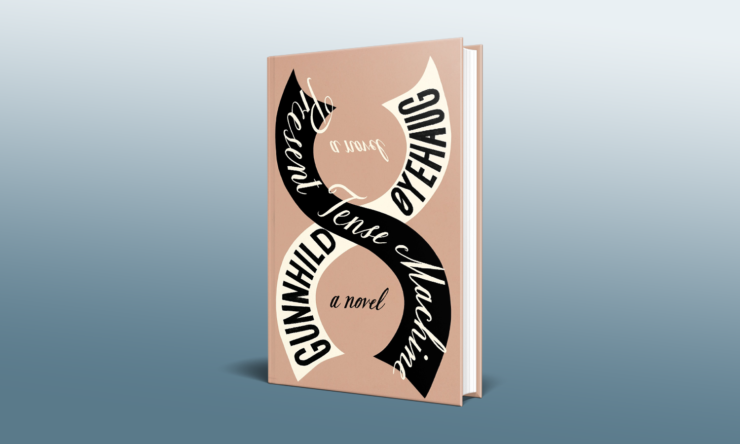Gunnhild Øyehaug’s Present Tense Machine, translated by Kari Dickson, is a novel about parallel universes. In that way, it’s like a host of other novels—some long and others short, some intimate in their scope and others focusing on the largest possible canvas. What makes Øyehaug’s novel stand out is the relative modesty of its scale, along with a tone that’s at once playful and philosophical.
Early in the novel, its narrator (who seems to be Øyehaug herself, or at least a similarly omnipotent presence in the narrative) cites one character’s argument around several films that “are based on the idea of parallel universes”—in this case, Interstellar, Arrival, and Doctor Strange. And while those works don’t necessarily have a lot in common, they do end up serving as an early point of contrast to the narrative of Present Tense Machine.
There certainly are cinematic works that deal with parallel universes or timelines more in line with what Øyehaug does in Present Tense Machine, including Sliding Doors, Blind Chance, and Run Lola Run. In terms of fiction, it would fit comfortably on a reading list beside Ken Grimwood’s Replay and Paul Auster’s 4 3 2 1. At the heart of Present Tense Machine are a mother and daughter, Anna and Laura, who are separated by a cosmic boundary from early in Laura’s life.
In 1998, when Laura is two years old, Anna sits in a garden reading a book when she misreads a single word within it. Specifically, it’s the Swedish word trädgård, which means “garden.” Anna reads it as tärdgård—and that’s when things get strange. “[B]y misreading the word in precisely this way, as though some mysterious higher being had grafted this potential onto the word, a parallel universe would open,” writes Øyehaug. And from there, Laura exists in one universe and Anna exists in another, each vaguely feeling that something was lost, but moving on with their lives.
Buy the Book


Present Tense Machine
“We know that it’s hard to believe,” Øyehaug writes, via Kari Dickson’s translation. “But that is in fact how it happened, and no other way.”
Present Tense Machine is not a long book, and its concerns are relatively quotidian. In the scenes in the novel set in the present day, Øyehaug describes scenes from both timelines—with Laura’s pregnancy being an area of particular focus. Largely, however, the novel feels less like a traditionally plotted work and more like a series of vignettes structured around an all-seeing narrator’s commentary on fate, memory, and the quirks of life. (Think Stanisław Lem, think Michael Cisco.)
There is, for instance, a moment where a version of the man who Anna is married to in one timeline encounters Laura. Øyehaug writes that “he has not even the faintest idea that the woman standing there is the daughter of the woman he’s married to and has two children with in a parallel universe.”
Early in Present Tense Machine, Anna ponders Georges Perec’s novel A Void, about a mysterious disappearance and written without using the letter “e.” Perec was a member of the Oulipo, a literary movement whose members include Raymond Queneau and Italo Calvino. Serendipitously—or perhaps not, given Present Tense Machine’s surreal view of the universe’s mechanics—Øyehaug’s novel is being released in English translation in close proximity to The Anomaly, a novel by Oulipo member Hervé Le Tellier. And the two books make for an interesting study in contrasts, as both explore strange and seemingly impossible events.
In The Anomaly—spoilers ahead—Le Tellier literalizes the idea of double lives. The book is centered around the passengers on a Paris-to-New York flight who are duplicated under mysterious circumstances. Much of the second half of Le Tellier’s novel focuses on a number of characters attempting to understand why this took place, and whether it’s evidence of divine intervention, proof that our world is a simulation, or something else entirely.
In The Anomaly, two sets of the same people exist in the same world; in Present Tense Machine, the separation between two people creates two distinct worlds. But where Le Tellier’s exploration (and explanation) of the doubling is eminently philosophical, Øyehaug’s is ultimately more playful—and more resonant. The universe, she seems to suggest, has plenty of previously unseen properties that could come to the foreground at any time. That allows for moments of indescribable loss, but it also finds space for multiple universes to reach moments of quiet transcendence.
Present Tense Machine is not about parallel timelines in the same way that, say, Adrian Tchaikovsky’s Doors of Eden is—but it makes a good argument for why much smaller-scale stories of parallel universes can powerfully resonate with readers. While the narrator’s intrusions into the narrative can sometimes feel a bit random, the overall effect of loss and sense of missed connections makes for a powerful and unpredictable read. What does it mean to lose someone in a way that the world doesn’t seem to have language for? Present Tense Machine offers one answer.
Present Tense Machine is available from Farrar, Straus and Giroux.
 Tobias Carroll is the managing editor of Vol.1 Brooklyn. He is the author of the short story collection Transitory (Civil Coping Mechanisms) and the novel Reel (Rare Bird Books).
Tobias Carroll is the managing editor of Vol.1 Brooklyn. He is the author of the short story collection Transitory (Civil Coping Mechanisms) and the novel Reel (Rare Bird Books).










